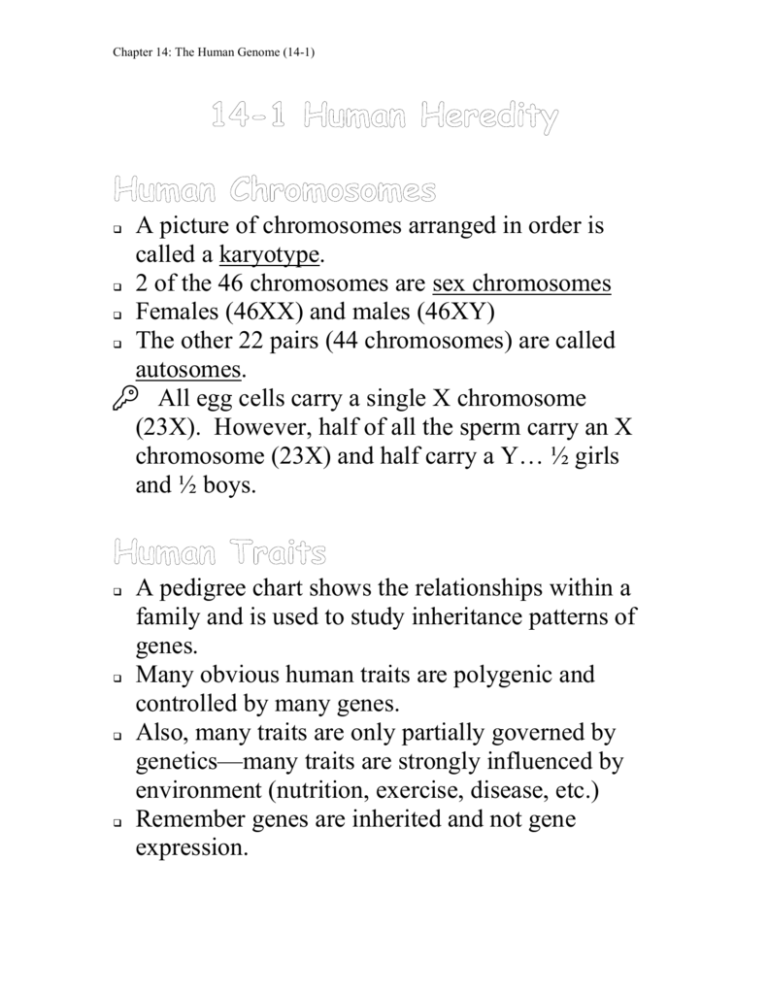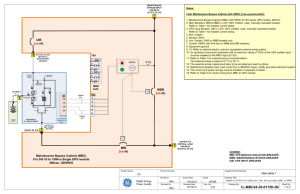14-1 Human Heredity
advertisement

Chapter 14: The Human Genome (14-1) A picture of chromosomes arranged in order is called a karyotype. 2 of the 46 chromosomes are sex chromosomes Females (46XX) and males (46XY) The other 22 pairs (44 chromosomes) are called autosomes. All egg cells carry a single X chromosome (23X). However, half of all the sperm carry an X chromosome (23X) and half carry a Y… ½ girls and ½ boys. A pedigree chart shows the relationships within a family and is used to study inheritance patterns of genes. Many obvious human traits are polygenic and controlled by many genes. Also, many traits are only partially governed by genetics—many traits are strongly influenced by environment (nutrition, exercise, disease, etc.) Remember genes are inherited and not gene expression. Chapter 14: The Human Genome (14-1) Genes that are denied a proper environment in which to reach full expression in one generation can, in a proper environment, achieve full potential in a later generation. Rh blood group is controlled by a single gene—2 alleles (+, -) + is dominant over – ABO blood group is more complicated: o Three alleles (IA, IB, and i) o IA and IB are codominant (these alleles produce antigens that are recognized by the immune system) o i (no antigens are produced) A B AB O I AI A IBIB I AI B ii I Ai IBi ------- Chapter 14: The Human Genome (14-1) PKU (phenylketonuria)— Lack the enzyme that is needed to break down phenylalanine, a common amino acid found in many foods. Causes build up of phenylalanine—leads to severe brain damage/mental retardation Tay-Sachs— Affects Jewish families with central/eastern European ancestry. Causes fats to build up in the brain NO CURE! Early childhood death Achondroplasia (most common from of dwarfism) Huntington’s disease (progressive loss of muscle control/mental function until death) Sickle cell disease (1 in 500 African Americans) Why??? A combination of genetics, history and human biology Chapter 14: The Human Genome (14-1) How do the actual DNA sequences in genes affect the phenotype? In both cystic fibrosis and sickle cell disease, a small change in the DNA of a single gene affects the structure of a protein, causing a serious genetic disorder. Cystic Fibrosis Common fatal genetic disease Recessive allele Digestive problems/thick heavy mucus that clogs lungs ½ of children do not survive into their 20’s Cause: a deletion of 3 bases in the middle sequences of a protein (removes one a.a.) The cell membrane cannot pass Cl- ions because the protein channel (CFTR) is destroyed. Sickle Cell Disease Red blood cells are bent and twisted Get stuck in the tiny capillaries…like little damns in the blood vessels. Damage to tissues, brain, heart, spleen, and tissues, physical weakness, bruising, etc Cause: one nitrogen base is substituted for another causing valine to be in place of glutamic acid Chapter 14: The Human Genome (14-1) When oxygen levels are low, the blood cells change shape and stick together Why does this affect people with African descent? Malaria, a parasitic disease infects red blood cells. HAHA (normal) HAHS (carrier) HSHS (sickle cell sufferer) Can die of Malaria Not affect by SCD nor Malaria Severely affected by the disease












